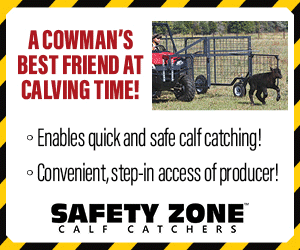A look at a grazing principle that dates back almost four decades
By Loretta Sorensen
Rangeland in southwest North Dakota gets thirsty, typically receiving less than 13 inches of rain over summer. That droughty climate, coupled with evolving beef production methods, has driven North Dakota ranchers like Wendell and Linda Vigen and Chester and Jane Brandt to pursue every possible option for making the most of every raindrop and every bite of grass on their ranches.
Twice-over grazing is one of the practices both ranchers adopted in the 1980s when North Dakota State range scientist Lee Manske was promoting the new grazing principle he began studying in the late 1970’s.
Manske’s twice-over grazing was developed to give ranchers a “relatively simple design” that could be modified to fit individual ranch operations. Manske recommended use of three, four or five pastures, which allowed for greater use of forage in each pasture while minimizing the need for fencing and water development.
While both the Vigens and Brandts have modified that basic practice over the years, it was their starting point for overhauling the traditional grazing methods they grew up with.
Bar Z Ranch Story
“This ranch, the Bar Z, was homesteaded by the Brown family and several generations of Browns raised about 100 cattle here, like most of the ranches did in that day,” Wendell Vigen relates.
The Bar Z, situated in the Killdeer Mountains 20 miles northwest of Killdeer, is now owned by the Alwin Carus Trust and operated by Vigen and his wife. On some 4500 acres, the Vigens run about 240 cow/calf pairs. Like most of their peers, rising feed costs and the cost of living set the stage for them in the 1980s to look for ways to produce more beef on the same number of acres.
“Natural Resources Conservation Service (NRCS) introduced us to twice-over grazing,” Vigen recalls. “We started with small changes, like installing a dam to hold back rainwater and runoff, and cross fencing to divide up our pasture. Over time we also dug and developed springs to put water in each pasture.”
Since the Bar Z sits on the edge of North Dakota’s Badlands, pasture sizes in Vigen’s twice-over grazing plan varied according to the terrain. Cross- fencing divided each grazing area into three or four pastures, which the Vigens used in rotating 125 head of cattle so each pasture was grazed no more than twice each growing season.
It took time for the Vigens to see improvements in their rangeland, but the first year of using twice- over grazing they saw gentler cattle because they were moving them so frequently. They also added about 20 pounds per calf at weaning the end of that first grazing season.
“The second year we used twice-over grazing we started seeing more grass and cows were grazing each pasture more thoroughly,” Wendell Vigen says. “We also saw great improvement in water infiltration rate. Before implementing twice-over grazing, we did an infiltration test in a selected pasture area and it took the water forever to soak into the soil. After two years of twice-over grazing, with a second infiltration test, very little of the water in that same area ran off instead of soaking into the ground.”
The Vigens used written records to document how many cattle were in each pasture for a season and how long they grazed each pasture. By the end of the third season using twice-over grazing, the Vigens found they had more winter grazing available, too. Since their annual hay crop was typically small, access to winter grazing was key to their profitability.
By the third grazing season, the Vigens increased the herd size from 125 to 170. Because their grazing plan was stimulating more grass growth, they not only had more forage to feed more cattle, they also had better winter grazing and room to set aside an area just for spring calving.
“As we’ve gotten older, and aren’t as able to move cattle every 10 days, we’ve increased the size of our pastures from 300 or 400 acres to as much as 450 acres,” Wendell explains. “When we first started the grazing system we moved cattle like clockwork, every 10 days. Now we observe the cattle to see if they’re waiting to be moved or still content grazing the pasture where they are. Sometimes we open the gate between two pastures and allow the cows to drift back and forth.”
Over the years, the Vigens have been able to suppress growth of some undesirable plants, like club moss, and promote growth of diverse grasses such as bluestem, buffalo grass and Grama. By 1996, the first year for Dunn County’s North Dakota Stockmen’s Association Environmental Stewardship Award, the Vigens were the first recipients of the award. In 1998 they were named Range Managers of the Year and also received the National Cattlemen’s Beef Association Annual Environmental Stewardship Award.
“Our story isn’t as much about winning awards as it is helping other beef producers learn what steps they could take to lease a ranch,” Wendell says. “We want ranchers to know that, even if they’re working someone else’s rangeland, they can make the land better and improve their own bottom line.”
Brandt Ranch story
The twice-over grazing story on the Chester and Jane Brandt Ranch northeast of Hebron, North Dakota, is similar to the Vigens. On 2400 acres of “pretty rough” ground, the Brandts typically see less than 15 inches of annual precipitation. Forage varieties range from western wheatgrass and prickly pear cactus on their clayey flats to sandreed and needlegrasses on the hills and blue grama with silver sagebrush on the buttes.
“My grandparents came here from Russia in 1910 when my dad was just five,” Chester says. “My brother and I were partners here until 2013 when he passed away. In 2014 I seeded the last 100 acres we used to farm so the land can be hayed or grazed.”
A late 1980’s drought pushed the Brandt’s to implement twice-over grazing for their 200+ cattle herd. They depended on dugouts and dams for water in their newly-created pastures until 1990, when they dug a well, which allowed them to begin installing pipeline to supply water. Pasture sizes, depending on terrain, range in size from about 80 acres to a maximum 160 acres.
“When we first started twice-over grazing I expected to be out working with cattle all the time,” Chester says. “That wasn’t the case. The cattle became so used to being moved that just the sound of our four-wheeler or pickup would cause them to head toward the gate. If I wanted to just check on the cattle, I had to do it quietly.”
Since 2008, when severe drought caused them to sell down their cattle herd, the Brandts have changed their ranching operation to graze 125 cow/calf pairs and 375 yearlings a Montana rancher brings in each spring.
In addition to seeing forage production and diversity increase, the Brandts have noticed that rotating from pasture to pasture helps reduce fly load because it breaks the fly life cycle. Frequent moves allow the yearlings to become accustomed to people and help the Brandt’s learn more about cattle behavior.
“The yearlings are generally here from late March ‘til fall and I see them every day,” Chester says. “I’ve learned that it’s easier to teach the yearlings to follow me when we’re ready to move than it is to try and push them somewhere. I’ve also realized that, if cattle are in the far corner away from the gate when it’s time to move, I wait till they move closer. There are different reasons they move into an area, such as heading into the wind to keep flies away. If I work with their natural behavior, everybody does better.”
Once the yearlings learn the Brandt’s system, they come running when they see mineral feeders being moved because they know they’re going to a new grazing area.
As beneficial as twice-over grazing has been for these North Dakota ranchers, they know that individual ranches have to customize their grazing strategy.
“This system isn’t for everyone,” Wendell Vigen says. “Making it work depends on labor resources and other daily obligations. It has worked very well for us, not just increasing the number of cattle we can run but also increasing the type and numbers of wildlife on the ranch. We’ve been able to develop a bow hunting business with all the wildlife we see.”
Vigen also notes that some livestock producers develop more in-depth grazing practices, seeing additional benefits. For ranchers who want to keep their operation simple, twice-over grazing can result in significant improvements.


